Forehead lift and brow lift are often considered synonymous and are commonly used interchangeably. However, by reading this text, we can understand the difference between the two. The eyebrow forms the lower part of the forehead, and the main part of the forehead is located above the eyebrow. Changes and signs of aging can occur in one of these two areas (either the lower forehead or the higher parts of the forehead) but not in the other.
For example, a person may only have sagging eyebrows while the higher parts of the forehead are completely smooth and youthful. Therefore, during a lift, we can lift each of these parts separately or together.
If the sole purpose of the surgery is to elevate the eyebrows, we call it a brow lift (endoscopic lifts often serve this purpose). If the goal is solely to rejuvenate the forehead, we call it a forehead lift. In most cases, we aim for both, and we call it a forehead and brow lift. When we perform only a forehead lift, we are essentially trying to correct forehead wrinkles, and the position and shape of the eyebrows may not change significantly.
Interestingly, the changes we make to the forehead and eyebrows through surgery are not only for rejuvenation but also for aesthetic purposes and reshaping. A young woman seeking a temple lift, or someone undergoing gender transition who wants a feminized forehead, is aiming for a change in facial shape and beauty. For them, we perform a brow or forehead lift.
In addition to non-surgical methods of forehead lifting (Botox injections, fillers, thread lifts), there is also surgical forehead lifting. However, surgical methods are used when non-surgical methods are ineffective.
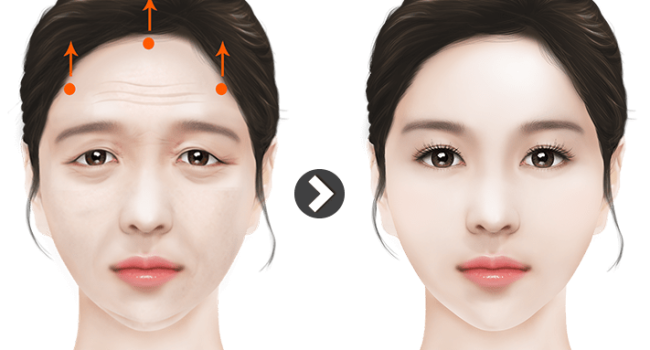
There are various surgical methods for the upper third of the face (forehead). These procedures are used to alter and rejuvenate the forehead and surrounding areas. Each of these methods has its own subcategories.

Many individuals seeking a forehead lift are familiar with only one or two of these methods and may not be able to find the most suitable option to achieve their desired outcome. In fact, some people could achieve better results with a minor surgery but, due to choosing an inappropriate method, may not achieve some of their goals despite the cost. To illustrate this point, consider the following example:
Imagine a young man with very deep forehead wrinkles that have not improved with any non-surgical rejuvenation methods. He has researched endoscopic forehead lifts online. However, all experienced surgeons have advised him against an endoscopic forehead lift. Why?

Their only request is to eliminate the deep wrinkles on their forehead, and endoscopic forehead lift can only stretch the deeper layers of the forehead. This stretch is not enough to reach the subcutaneous layer and smooth such thick skin. The doctors’ diagnosis and recommendation are completely correct, but this does not mean that there is no way to correct the wrinkles. Such a person is better off using a mid-forehead lift. If people like them undergo endoscopic lift surgery, in addition to incurring costs, they will not achieve their desired result.
Based on the above example, we realize that it is better to first identify and examine the unpleasant symptoms that have occurred on your forehead and caused you dissatisfaction, and then determine the best way to correct them based on their type and severity.
Contact us via WhatsApp for offline consultation.
With age, some people experience unaesthetic facial features. In the following article, we will discuss six of these signs and solutions for a more beautiful face.
This is one of the most common signs of aging on the forehead. Men experience eyebrow sagging more often and earlier than women. In the early stages of this sagging, its symptoms can be reduced with Botox injections and other non-surgical methods, but eventually, most people become candidates for eyebrow lift surgery. This surgery can be performed endoscopically or openly, and to choose the best method, it is better to consider other accompanying symptoms that occur with age.

Gentlemen who inherit low-set eyebrows may seek forehead and eyebrow lift surgery at a young age (under 30). Typically, due to thick skin and inflexible soft tissue, non-surgical methods are not very effective in such cases. However, it is better to try one or more non-surgical methods to correct it first.
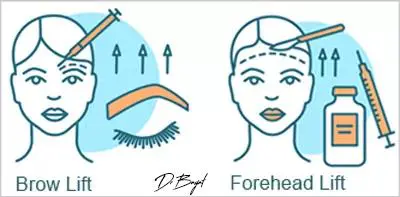
These are among the most common signs of aging on the forehead. Fortunately, most of these wrinkles (especially frown lines) respond well to Botox injections in the early stages and can spare the individual from any other procedures for a long time. The use of fillers can also produce better results alongside Botox injections. In some individuals, non-surgical methods are not effective, and those with very deep wrinkles may benefit from a forehead lift surgery.
In the lateral part of the forehead, there is no elevator muscle for the temporal tissue and lateral eyebrow. Instead, the orbicularis oculi muscle and gravity constantly pull these tissues downward, causing them to sag. Some people have genetically low-set lateral eyebrows. These individuals show signs of sagging tissue in the temporal region even in adolescence. In these individuals, we can correct the signs of sagging with temporal lift surgery in the early years of youth. Those seeking a temporal lift are often young people who want to raise the lateral eyebrow and change the shape of the eye area.
Note: The temporal region is anatomically considered part of the forehead. In all reputable plastic surgery books, whenever cosmetic surgery of the forehead is discussed, the surgery of the temporal region is also mentioned. Recently, temporal lift has gained many followers in Iran. It is best to simultaneously consider other forehead defects and correct them at the same time.
Increased forehead length is a hallmark of aging, especially in men. With hair loss and receding hairline, the distance between the eyebrows and the hair (forehead length) increases. In people with severe hair loss, in addition to being unattractive, this alone can make a person look 5 to 10 years older than their actual age. This has a very negative impact on a person’s mood. Fortunately, hair transplantation can solve the problem for many men. Some women are reluctant to have hair transplants and prefer to have a shorter forehead without a transplant. (Transplanted hair is often thicker than the hair on the front of the forehead, which makes others aware of the secret of hair transplantation in women). In these cases, we can consider forehead shortening surgery. Simultaneously, other forehead corrections (such as temporal lift, eyebrow lift, correction of forehead prominence) can also be performed.

A prominence in the lower part of the forehead is due to excessive growth of the frontal sinuses. Typically, the growth of these sinuses continues during puberty until the growth plate of the bone closes. However, sometimes it continues to grow even after this period. Fortunately, this condition is less common in women and usually does not require surgery. In men, a slight forehead prominence is acceptable, but in cases where this prominence is excessive, especially in individuals who also have drooping eyebrows, the person’s face may appear somewhat harsh and angry, creating an unpleasant feeling for the individual.
The atrophy of muscle and fat in the temporal region is commonly seen with aging. Fortunately, many of these atrophies are mild and can be corrected with fat or filler injections. We use a temporal prosthesis when the atrophy of the temple is very severe, and the individual does not even have enough fat for injection.
In addition to the above changes, which many doctors and people in society are aware of, changes may occur in the forehead with age. The reason why these changes are less noticed can be attributed to the following factors:
a) Not all people show these symptoms.
b) These changes are sometimes seen paradoxically (i.e., opposite to the normal state).
The most important unknown or little-known changes in the forehead include the following:
1.In some individuals, with increasing age, the eyebrows not only go down but also rise compensatorily. Therefore, a facelift is not effective in them, and the proportions of the forehead components must be adjusted in them.
2.In some individuals, due to relative atrophy of the surrounding tissues and slight growth of the main region, a relative prominence is created. This condition is more well-known in some parts of the face. In some elderly individuals, we see that despite the atrophy of facial tissues, the earlobe and nose continue to grow. The rim of the eye socket is one of the parts that becomes relatively prominent. Despite fat injection, forehead lift, and eyelid surgery, this prominence is still evident.
3.In some individuals, the most important change in the eyebrows with age is the approximation of the eyebrows and forehead tissues to the midline.
Now that we have examined the signs of facial unaesthetic, we will evaluate the methods of correcting them. A complete forehead and eyebrow lift can be performed open or endoscopically.

In this method, depending on the patient’s condition, the incision can be made in the middle of the forehead (Midforehead), at the hairline (pretrichial), or within the hair (bicoronal).
1.Multi-layer lift: The lift can be performed on more than one layer of tissue.
2.Bone shaving and forehead contouring: It allows for the reshaping of the forehead bone to correct prominences.
3.Long-lasting results: Provides the most durable results compared to other methods.
4.Graft placement: Grafts can be placed in the upper eyelid hollows (A-frame deformity) or other areas of the forehead.
5.Subcutaneous lift: Allows for a deep lift of the underlying tissues, addressing various forehead issues.
6.Combined approach: A combination of subcision (to release skin adhesions) and deep tissue lift can be performed for certain cases.
1.Long incision: The incision is longer compared to endoscopic methods.
2.Prolonged itching: Patients may experience itching for several months after surgery.
3.Prolonged numbness: Numbness of the scalp can last for a long time.

In this procedure, an incision is made in the middle of the forehead. This approach is quite rare and is typically used for individuals over 50 years old or those with very deep forehead wrinkles. The reason for this is that in older individuals, scars tend to heal better, and there is less concern about visible scarring. (Note that this method is slightly different from a Mid-forehead brow lift.) This method is less commonly used for younger individuals (under 40).
1.Effectively corrects wrinkles and excess skin on the forehead.
2.Can be performed under local anesthesia.
3.Has a short recovery period.
1. A visible scar remains in the middle of the forehead.
2. Primarily lifts the inner portion of the eyebrows, not the temples (unless the incision is extended laterally).
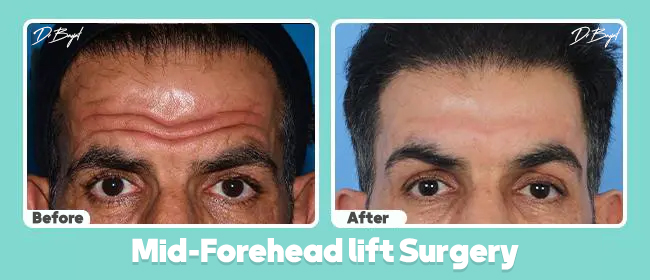
In this procedure, an incision is made just in front of the hairline. This technique is suitable for younger individuals as well.
1.Prevents forehead lengthening: Unlike other methods, this approach doesn’t make the forehead appear longer. In some cases, it can even shorten the forehead.
2. Enhanced subdermal lifting and rhytidectomy: This method allows for more precise deep tissue lifting and facial rejuvenation, leading to improved results.
3. Effective removal of forehead fillers: Excess fillers can be more easily removed using this technique.
Visible scar: The scar from the incision may be noticeable. Patients may require additional treatments like laser therapy or hair transplantation to minimize the scar’s appearance.
In essence, this surgical approach offers a more precise and customizable way to lift the forehead, particularly for younger individuals who wish to avoid an elongated forehead appearance. However, the potential for a visible scar is a consideration that patients should discuss with their surgeon.

In this procedure, an incision is made within the hairline. By pulling the deep tissues and removing excess skin, the hairline is slightly receded, increasing the length of the forehead.
The incision is hidden within the hairline.
1.The forehead becomes longer.
2.There’s a risk of hair loss along the surgical incision.

In endoscopic surgery, several small incisions (3-5) are made, and surgical instruments are inserted through these incisions. The procedure is guided by an endoscope. After lifting the tissues, they are pulled upwards and fixed in the new position using sutures or endostitches. Note that using endostitches is not a separate surgical method; they simply serve as fixation sutures.
1. The biggest advantage is the smaller incision size.
2. Shorter surgery time compared to open methods.
Disadvantages:
1. Excess forehead skin cannot be removed. Therefore, while the eyebrows are lifted, the distance between the eyebrows and hairline doesn’t decrease.
2. Forehead wrinkles are not significantly reduced (rhytidectomy is not performed). If wrinkle correction is needed, additional procedures like subcision may be required.
3 Due to fewer incisions and limited access for tissue fixation, fewer sutures are used. This means the results may not last as long as open methods, and recurrence is more likely in individuals with thick skin (young people, especially men).
Note: Endostitches can replace endoscopic sutures and make the procedure easier for the surgeon. However, they are not as reliable as permanent sutures used in open procedures, as endostitches are absorbed within nine months and lose their tensile strength in less than six months.
This article aims to introduce you to the latest and most popular brow lift techniques, along with their advantages and disadvantages.
1. Endoscopic Brow Lift:
Endoscopic brow lift is a popular method, but it’s not suitable for everyone. Patients with a high forehead or those whose hairline starts far back may not be ideal candidates for an endoscopic brow lift.
2. Pretrichial Brow Lift:
A pretrichial brow lift is considered an alternative to the endoscopic brow lift. This surgery typically involves making an incision in front of the hairline, allowing patients to both improve their eyebrow position and achieve a shorter forehead.

3. Trichial/Bicoronal Brow Lift
A trichial brow lift is similar to a pretrichial lift, but it does not shorten the forehead. In a bicoronal or trichial lift, the eyebrow is raised by removing a specific amount of forehead skin.
4. Temporal Brow Lift
A temporal brow lift, often performed in conjunction with blepharoplasty, elevates the outer end of the eyebrow, which can give the brow a more feminine, arched appearance.
5. Direct Brow Lift
A direct brow lift is a suitable option for male patients who are balding or have thin hair. In this method, an incision is made directly above the eyebrow, and the brow is lifted.

6. Mid-Forehead Brow Lift
In this procedure, a surgical incision is made in the middle of the forehead. It is particularly suited for individuals with deep wrinkles in the center of their forehead. This method directly addresses and removes these wrinkles.
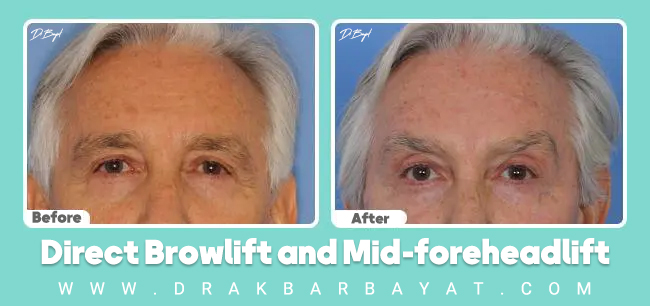
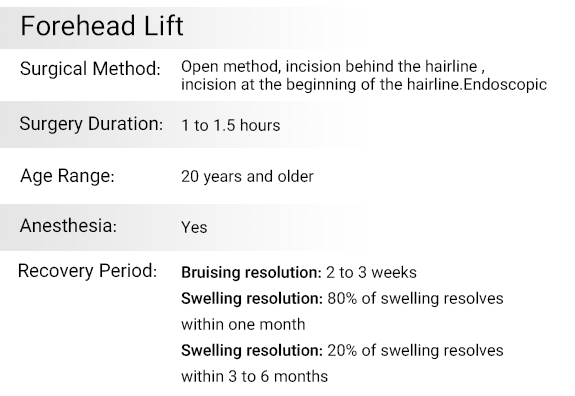
DR AKBAR BAYAT
Bord certified facial plastic surgeon
Reshaping the bone has absolutely no impact on the longevity of a brow lift. It’s solely used to correct irregularities or unattractive features of the forehead bone.
If the inner part of the eyebrows is close to the eyes, a forehead lift is better. However, if the outer part of the eyebrows is close to the eyes, a temporal lift should be performed. Most people find that a temporal lift is sufficient.
No. A forehead lift does not affect the size of the eyes.
We have several options in this surgery. We can cut part of the muscle, the entire muscle, or even remove it. However, it’s best to consider the long-term results of this to avoid creating an unnatural or masked appearance.
Yes, to some extent. However, upper eyelid puffiness can have various causes, such as drooping eyebrows, drooping eyelids, bone growth, or injections of fat or filler. A forehead lift will address the portion of the puffiness related to drooping eyebrows.
Botox injections are very effective in enhancing and prolonging the results of a forehead lift.
If the asymmetry is significant (for example, in cases of stroke), the eyebrows can be made more symmetrical.
However, minor asymmetries cannot be corrected through surgery, and it’s important to note that perfect symmetry can never be achieved.
These are essentially the same surgery, but the name changes depending on the specific area we want to improve. If the goal is to correct the eyebrows or the appearance of the forehead, we use the corresponding name.
For facial wrinkles, it’s best to try non-surgical methods first. Most forehead lifts do not significantly change forehead wrinkles. If you want to address forehead wrinkles, a forehead rhytidectomy, which is slightly different from a standard forehead lift, is recommended.
In most surgeries, including forehead lifts, some of the sensory nerve branches are cut during the procedure. After surgery, other nerve branches compensate for the lost sensation. Therefore, the sensation in the upper part of the head will be different than before surgery.
As long as the results of the previous lift are still present, there is no need for another lift. If there are signs of recurrence, you can consult your surgeon for another lift.
Numbness persists as long as there is swelling and the tissues are healing. It usually takes several weeks to a few months for the swelling to subside and the numbness to resolve.
In general, tissue healing is slower in smokers compared to non-smokers, and there is a risk of tissue damage. Therefore, it’s best to stop smoking before surgery. Smokers are also at a higher risk of developing scars.
A forehead lift can reduce this line but not completely eliminate it.
Drains prolong the recovery period. Dr. [Doctor’s name] uses A-net (cookie) sutures instead of drains.
Incisions for brow, forehead, and temporal lifts are made within or between the hairline and scalp. The exact location varies for each individual and will be determined during the preoperative consultation.
The recovery period for this surgery is one to two weeks, and it is performed under general anesthesia.